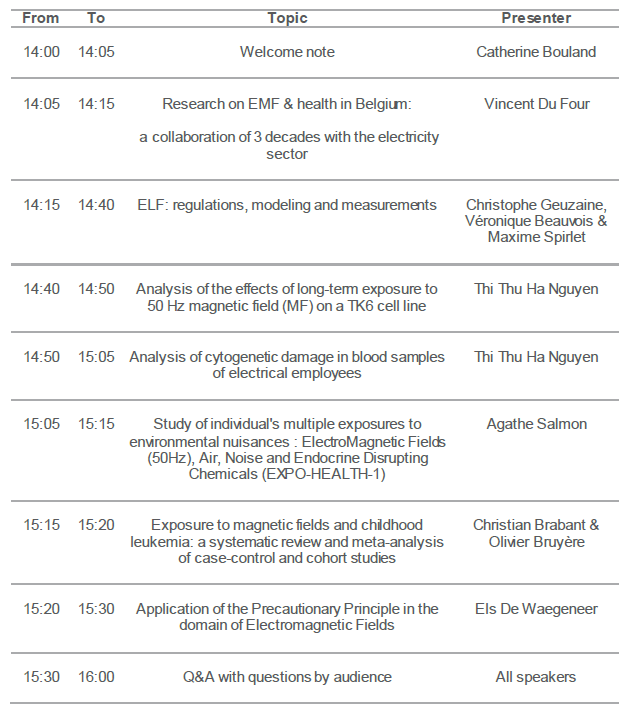![]() Low frequency electromagnetic fields and health. Results of 4 years of research by the Belgian BioElectroMagnetics Group.
Low frequency electromagnetic fields and health. Results of 4 years of research by the Belgian BioElectroMagnetics Group.
BBEMG study days
21 March 2022
Watch the webinar (2022) here

The presentation (in English) is available below.
The presentations (in PDF format) are available on the following page.
We also received a few questions that could not be answered in the presentation itself. Below you will find these questions and their answers.
Question for Agathe Salmon in reference to her study on exposure to multiple exposures to environmental nuisances. Does your study take into account the difference between 50 Hz EM-fields at night and during the day (rush)?
Alike for the study with electrical employees, the study in population will be able to differentiate the exposure to the multiple pollutants of interest according to the type of environment people report to be in and according to the time of the day. However, the participants don’t wear the EMDEX II device during the night: They leave it somewhere in their room, where it may either be away from any source of ELF-EMF or next to one and therefore register high levels of fields not being the real exposure of the person. For this reason, we won’t take into account the night data for the ELF-EMF measured.
A question to Dr. Christian Brabant, regarding the meta-analysis around exposure to ELF EMF and the occurrence of childhood leukemia. Does this meta-analysis also provide information on causality, or is this a comparison between the incidence of childhood leukemia and exposure. (Is there a causal relationship or just a correlation?)
Our meta-analysis does not provide information about causality. We do not propose a biological mechanism. If the association we have found between extremely low frequency magnetic fields and childhood leukemia is real, our meta-analyses suggest that the subtype of leukemia is acute lymphoblastic leukemia. Moreover, our work suggests that only prolonged exposure to magnetic fields above 0.4 µT could increase the risk of developing leukemia.
An addition to a question answered by Dr Christian Brabant, regarding the meta-analysis on ELF-EMF exposure and the incidence of childhood leukaemia. In addition to the study presented by Christian, there is another study that found there is still an association present.
The author of this question probably refers to the recent study by Núñez‐Enríquez and colleagues published in 2020 (Bioelectromagnetics, 41, 581—597). They have found an association between extremely low frequency magnetic fields higher than 0.4 µT and B‐lineage acute lymphoblastic leukemia in children living in Mexico. This study has been included in our meta-analyses.
A question to Dr. Christian Brabant, regarding the meta-analysis around exposure to ELF EMF and the occurrence of childhood leukemia. (Seomun G, Lee J, Park J; 2021) has shown that significant associations were still observed between exposure to extremely low frequency magnetic fields and childhood leukemia. Do you have any comments about this?
Dr Seomun and colleagues (2021, PLoS One, 16, e0251628) have recently performed a meta-analysis about the association between extremely low frequency magnetic fields (ELF-MF) and different childhood cancers. Nevertheless, their work did not focus on childhood leukemia, the different subtypes of leukemia have not been analyzed separately and distances to power lines have not been examined. Unfortunately, it is very difficult to compare our results with those of Dr Seomun. In two of their meta-analyses performed on childhood leukemia cases, they have not noticed that the studies by Bunch et al. (2015; J Radiol Prot 35, 695-705) and Kroll et al. (2010, Br J Cancer 103, 1122-1127) are based partly on the same data from the National Registry of Childhood Tumours and thus many of the cases are the same in these meta-analyses. Since there are many cases counted twice from these two British studies that detected high odds ratios, the meta-analysis performed by Seomun and colleagues overestimates the association between ELF-MF and childhood leukemia. Moreover, they have counted the study of Feizi and Arabi (2007; Asian Pac J Cancer Prev 8, 69-72) that used a cutoff of 0.45 µT in their meta-analysis supposed to use 0.4 µT as a threshold. The reference category of this study was < 0.45 µT (and not < 0.1 µT like in Kroll et al., 2010 and in most studies). As a result, the inclusion of the studies of Kroll et al. (2010) and Feizi and Arabi (2007) led Seomun and colleagues to calculate an odds ratio (OR) of 1.72 (95% CI 1.25 – 2.35) for magnetic fields higher than 0.4 µT and childhood leukemia, an OR that is largely overestimated with an undefined reference category.
Question for Agathe Salmon in reference to her study on exposure to multiple exposures to environmental nuisances. Which low frequency EMF generators have been identified till now yet in your study if applicable?
At this moment, we haven’t started the analysis of the data because we have only obtainedreached almost half of the samples we are planning on using in this study. With the data being gathered in the study, we will know the levels of exposure of the participants and, thanks to the questionnaire, we will also have an idea of the amounts of domestic sources of ELF-EMF for each participant. We will also have a general idea of the on-street sources from the electric distribution infrastructures. Attributing the exposure to precise sources will not be possible, but we will test associations between people’s exposure and the number of domestic sources / electrical infrastructure sources.
Question to Dr. Christian Brabant, Amoon et al. (2021). had analysed 3 pooled analysis including Ahlbom et ail. (2000) and Kheiftes(2010). A meta-analysis of the three pooled analyses overall presents an OR of 1.45 (95% CI: 0.95–2.20) for exposures ≥0.4 μT. Do you have a comment on this?
Dr Amoon and colleagues (2022, Environmental Research, 204, 111993) have performed a meta-analysis of three pooled analyses: the pooled analysis by Ahlbom et al (2000, Br J Cancer, 83, 692-8) with studies published before 2000, the pooled analysis by Kheifets et al. (2010, Br J Cancer, 103, 1128-35) based on studies published between 2000 and 2010 and their pooled analysis based on 4 studies published after 2010. Their meta-analysis of these three pooled analyses found a pooled OR of 1.45 (95% CI 0.95-2.20) for magnetic fields higher than 0.4 μT. These results are close to ours published in Reviews on Environmental Health (Brabant et al., 2022) since we have found a pooled OR of 1.37 (95% CI 1.05-1.80) for the association between magnetic fields higher than 0.4 µT and childhood leukemia in our work.
September 22, 2017
Champs électromagnétiques de basses fréquences et santé. Résultats de 4 années de recherches du Belgian BioElectroMagnetics Group.
Laag frequente elektromagnetische velden en gezondheid. Resultaten van 4 jaren onderzoek door de Belgian BioElectroMagnetics Group.
See the presentations of the 2017 study day (Slides in French/Dutch)
Champs électromagnétiques de basses fréquences et santé.
Résultats de 4 années de recherches du Belgian BioElectroMagnetics Group
Laag frequente elektromagnetische velden en gezondheid. Resultaten van 4 jaren onderzoek door de Belgian BioElectroMagnetics Group.
Prof. Dr. Luc Verschaeve (President), Dr. Annemarie Maes (Coordinator)
Introduction – Présentation du BBEMG et but de la journée d’étude
(Présentation)
Inleiding – Voorstelling van de BBEMG en doel van de studiedag
(Presentatie)
Prof. Dr. Luc Verschaeve
Champs électromagnétiques d’extrêmement basses fréquence
Effets sur la santé : État des lieux
(Présentation)
Extreem lage frequente elektromagnetische velden
Effecten op de gezondheid: stand van zaken
(Presentatie)
Dr. Christian Brabant
Recherches sur l’hypersensibilité électromagnétique
(Présentation)
Onderzoek naar elektromagnetische hypergevoeligheid
(Presentatie)
Maryse Ledent
Électro(hyper)sensibilité ou IEI-CEM : Réflexions et projets
(Présentation)
Elektromagnetische (hyper)gevoeligheid of IEI-EMV : Reflecties en projecten
(Presentatie)
Michel Goethals, Mart Verlaek & Prof. Dr. Geuzaine
Middelen voor het berekenen van velden en waarschuwingen voor hun misbruik
(Présentation, en néerlandais)
Dr. Jean_François Collard & Prof. Dr. Maurice Hinsenkamp
Coopération européenne en Science et Technologie: Action BM 1309 EMF-MED
(Présentation)
Europese Samenwerking in Wetenschap en Technologie (COST): Actie BM 1309 EMF-MED
(Presentatie)
Dr. Jean_François Collard & Prof. Dr. Maurice Hinsenkamp
Etudes sur la différenciation et la prolifération cellulaire
(Présentation)
Studie van de cellulaire differentiatie en proliferatie
(Presentatie)
Dr. Maurits De Ridder
L‘Arrêté Royal relatif aux champs électromagnétiques au travail
(Présentation)
Het Koninklijk Besluit elektromagnetische velden op het werk
(Presentatie)
Dr. Martine Souques
Mise en place d’une cohorte de retraités RTE professionnellement exposés au champ magnétique 50 Hz : le projet CohoRte
(Présentation)
Opzetten van een cohorte van RTE gepensioneerden die professioneel blootgesteld werden aan 50 Hz magnetische velden : het CohoRte-project
(Presentatie)
Willy Pirard, Benjamin Vatovez, Paul Bernard & Amélie Jacques
Champs électriques et magnétiques dus aux courants porteurs générés par les compteurs communicants
(Présentation)
Elektrische en magnetische velden van PLC die door smartmeters worden gegenereerd
(Presentatie)
September 18, 2013
Champs électromagnétiques de basses fréquences et santé. Résultats de 4 années de recherches du Belgian BioElectroMagnetics Group.
Laag frequente elektromagnetische velden en gezondheid. Resultaten van 4 jaren onderzoek door de Belgian BioElectroMagnetics Group.
See the presentations of the 2013 study day (Slides in French/Dutch)
Champs électromagnétiques de basses fréquences et santé.
Résultats de 4 années de recherches du Belgian BioElectroMagnetics Group
Laag frequente elektromagnetische velden en gezondheid.
Resultaten van 4 jaren onderzoek door de Belgian BioElectroMagnetics Group
Languages: French and Dutch
Introduction:
Prof. Dr. Luc Verschaeve (President), Dr. Annemarie Maes (Coordinator)
Pourquoi étudier les effets sur la santé des champs électromagnétiques à la fréquence du réseau 50 Hz ?
(Présentation au format pdf)
Waarom de gezondheidseffecten van 50 Hz elektromagnetische velden bestuderen? Voorstelling van de BBEMG en programma van de studie dag.
(Presentatie in het pdf formaat)
Maryse Ledent
BBEMG et communication : le site internet du BBEMG comme outil d’information.
(Présentation au format pdf)
BBEMG en communicatie: de internetsite van de BBEMG als informatie bron.
(Presentatie in het pdf formaat)
Dr. Maurits De Ridder
Études épidémiologiques des effets sur la santé des champs électromagnétiques de très basses fréquences.
(Présentation au format pdf)
Epidemiologische studies over de gezondheidseffecten van 50 Hz elektromagnetische velden.
(Presentatie in het pdf formaat)
Isabelle Demaret, Prof. Dr Marc Ansseau, Cindy Rocha
Recherches sur l’hypersensibilité électromagnétique
(Présentation au format pdf)
Onderzoek naar elektromagnetische hypergevoeligheid
(Presentatie in het pdf formaat)
Prof. Dr. Luc Verschaeve
Champs électromagnétiques et la maladie d’Alzheimer : un lien est-il possible ?
(Présentation au format pdf)
Elektromagnetische velden en de ziekte van Alzheimer: is er een mogelijk verband?
(Presentatie in het pdf formaat)
Prof. Dr. Maurice Hinsenkamp, Jean_François Collard
Études sur la différentiation et la prolifération cellulaire.
(Présentation au format pdf)
Onderzoek naar de effecten op celdifferentiatie en celproliferatie.
(Presentatie in het pdf formaat)
Dr. Patrick Dular, Prof. Dr. Ir. Christophe Geuzaine
Courants de contact et quantification des incertitudes dans les modèles électromagnétiques.
(Présentation au format pdf)
Contactstromen en quantificatie van de onzekerheden in de elektromagnetische modellen.
(Presentatie in het pdf formaat)
Dr. H. Reynders (LNE)
La position de l’administration flamande (LNE) sur les aspects sanitaires des champs électromagnétiques de très basses fréquences.
(Présentation au format pdf)
Positie van de Vlaamse overheid (LNE) m.b.t. de gezondheidseffecten van elektromagnetische velden met extreem lage frequenties.
(Presentatie in het pdf formaat)
Prof. Dr. Nathalie Schiffino (UCL)
Biopolitique et risque.
(Présentation au format pdf)
Biopolitiek en risico.
(Presentatie in het pdf formaat)
May 13, 2009
Environnement électrique basse fréquence : effets sur la santé?
Résultats de 4 années de recherches du Belgian BioElectroMagnetics Group (BBEMG)
Zijn magnetische velden vaan 50 Hz een risico voor de gezondheid?
Resultaten van vier jaren onderzoek door de Belgian BioElectroMagnetics Group (BBEMG)
See the presentations of the 2009 study day (Slides in French/Dutch)
Environnement électrique basse fréquence : effets sur la santé?
Résultats de 4 années de recherches du Belgian BioElectroMagnetics Group (BBEMG)
Zijn magnetische velden vaan 50 Hz een risico voor de gezondheid?
Resultaten van vier jaren onderzoek door de Belgian BioElectroMagnetics Group (BBEMG)
Languages: French and Dutch
Introduction:
Jean-Jacques Legros (President) & Marion Crasson (Coordinator)
Pourquoi étudier les effets sur la santé des champs électriques et magnétiques à la fréquence du réseau (50 Hz) ? – Présentation du BBEMG et du programme de la journée.
(Présentation au format pdf)
Waarom de gezondheidseffecten van elektrische en magnetische velden van 50 Hz bestuderen? Voorstelling van de BBEMG. Doel van de studiedag.
(Presentatie in het pdf formaat)
Maurits De Ridder
Champs électriques et magnétiques TBF et santé: Etudes épidémiologiques: qu’est-ce qu’une étude épidémiologique? Quels sont les problèmes de santé rencontrés? Comment comprendre le risque de leucémie et de maladie d’Alzheimer ?
(Présentation au format pdf)
Laagfrequente magnetische velden en gezondheid: Wat is een epidemiologische studie? Welke gezondheidseffecten bestudeert men? Hoe moeten we de gezondheidsrisico’s inschatten?
(Presentatie in het pdf formaat)
Gilbert Decat
Campagne de mesure de l’exposition aux champs magnétiques chez l’enfant en Belgique : sources et niveau d’exposition, comparaison avec d’autres pays.
(Présentation au format pdf)
Monitoring van de blootstelling van kinderen aan velden van 50 Hz in België. Bronnen, niveaus, en vergelijking met andere landen.
(Presentatie in het pdf formaat)
Jean-Louis Lilien
Courants de contact – Hypothèses, explications et modélisation.
(Présentation au format pdf)
De “Contact Current” hypothese. Achtergrond en modelbeschrijving.
(Presentatie in het pdf formaat)
Marion Crasson
Electrosensibilité (EHS): résultats des recherches et hypothèses explicatives.
(Présentation au format pdf)
Elektrische overgevoeligheid. Onderzoeksresultaten en hypotheses met betrekking tot de etiologie.
(Presentatie in het pdf formaat)
Patrick De Boever
Electrosensibilité (EHS): résultats des recherches génétiques.
(Présentation au format pdf)
Genetisch onderzoek naar elektrische overgevoeligheid.
(Presentatie in het pdf formaat)
Maurice Hinsenkamp
Etude in vitro des effets des champs magnétiques sur la différenciation et la prolifération cellulaire: intérêt de la recherche fondamentale et effets thérapeutiques.
(Présentation au format pdf)
In-vitro-onderzoek naar de effecten van velden van 50 Hz op cefdifferentiatie en -proliferatie. Fundamenteel onderzoek en therapeutische effecten.
(Presentatie in het pdf formaat)
April 27, 2006
Stress related psychophysiological and environmental factors that determine development and manifestation of electrohypersensitivity and similar functional disorders. Psychoneuroendocrinology Unit (BBEMG), Université of Liège, Belgium
By Prof. E. Lyskov, Centre for Musculoskeletal Research, University of Gävle, Umea (Sweden).
May 15, 2004
Journée d’information sur les effets potentiels des champs électromagnétiques sur la santé


